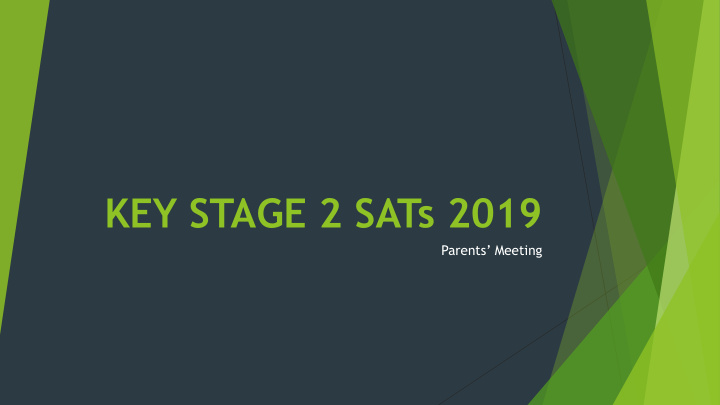



KEY STAGE 2 SATs 2019 Parents’ Meeting
Timetable Monday 13 May English Grammar, Punctuation and Spelling Tuesday 14 May English Reading Mathematics Wednesday 15 May Paper 1: Arithmetic Paper 2: Reasoning Thursday 16 May Mathematics Paper 3: Reasoning
What is the purpose of the SATS? To measure pupil progress from Key Stage 1 and their attainment Measured against age related expectations as set out in the National Curriculum. Results form the basis of further teaching and learning. Results can be used by secondary schools as a ‘baseline’ assessment, although on transfer to Year 7, test data is only part of the evidence that secondary schools use. To measure school performance To identify regional and national trends
SATS In the Summer Term of 2016, children in Year 2 and Year 6 were the first to take the new SATs papers. These tests in English and maths reflect the new national curriculum, and are intended to be more rigorous. The expectations of the children have significantly increased and the papers are harder. At the end of Year 6, children will sit tests in: Reading Maths Spelling, punctuation and grammar These tests will be both set and marked externally, and the results will be used to measure the school’s performance (for example, through reporting to Ofsted and published league tables). Your child’s marks will be used in conjunction with teacher assessment to give a broader picture of their attainment. Writing is teacher assessed, although it may be externally moderated.
Reading The reading test is a single paper with questions based on three passages of text. Your child will have one hour, including reading time, to complete the test. Some children receive 25% extra time.
Grammar, Punctuation and Spelling Grammar and Punctuation Selected response , e.g. ‘Identify the adjectives in the sentence below’ Constructed response , e.g. ‘Correct/complete/rewrite the sentence below,’ or, ‘The sentence below has an apostrophe missing. Explain why it needs an apostrophe.’ Spelling 20 sentences are read from a script; pupils then fill in blanks on their answer sheet, spelling the missing word.
Maths Paper 1: arithmetic , 30 minutes Papers 2 and 3: reasoning , 40 minutes per paper
Maths Papers 2 and 3 are reasoning papers: Geometry including angles, coordinates, rotation, reflection, symmetry Ratios and how to interpret them from fractions, percentages etc Charts and tables Units and measures including time, temperature, money, weight, volume. Shapes and their properties including triangles, hexagons and their angles. Roman numerals. Mean, median and mode.
Writing - working towards the expected standard Pupils write for a range of purposes and audiences: using paragraphs to organise ideas describing settings and characters using some cohesive devices within and across sentences and paragraphs using different verb forms mostly accurately using co-ordinating and subordinating conjunctions using capital letters, full stops, question marks, exclamation marks, commas for lists and apostrophes for contraction mostly correctly spelling most words correctly producing legible joined handwriting
Writing - working at the expected standard Pupils write for a range of purposes and audiences creating atmosphere, and integrating dialogue to convey character and advance action selecting vocabulary and grammatical structures that reflect the level of formality required using a range of cohesive devices, including adverbials, within and across sentences and paragraphs using passive and modal verbs appropriately using a wide range of clause structures, sometimes varying their position within the sentence using adverbs, preposition phrases and expanded noun phrases effectively using inverted commas, commas for clarity, and punctuation for parenthesis mostly correctly, and making some correct use of semi-colons, dashes, colons and hyphens spelling most words correctly from the Year 5/6 spelling list maintaining legibility, fluency and speed in handwriting
Working at a greater depth within the expected standard In addition, pupils write for a range of purposes and audiences: selecting verb forms for meaning and effect using the full range of punctuation taught at key stage 2, including colons and semi-colons to mark the boundary between independent clauses
How will they be scored? Raw scores are the total number of marks scored Raw scores are converted into scaled scores and used to report national curriculum test outcomes Pupils reaching the expected standard will have demonstrated sufficient knowledge in the areas assessed
Pupils scoring below 100 will have not reached the expected standard Pupils scoring 100 will have reached Scaled Scores the national standard Those scoring 110 or above will have exceeded the standard
Recommend
More recommend